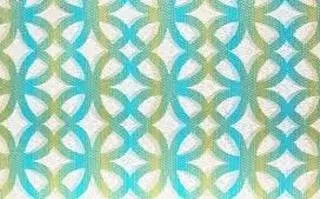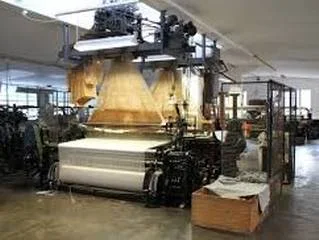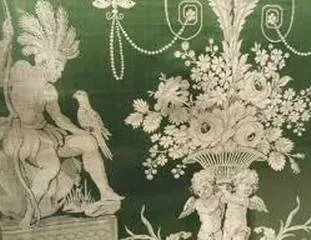Jacquard
The
term jacquard is not specific or limited to any particular loom but rather
refers to the additional control system that automates the patterning. The
process can also be used for patterned knitwear and machine knitted fabrics
such as jerseys. This use of replaceable punch cards to control the sequence of
activities is considered an important step in the history of computing
hardware.
Both
the Jacquard process and the necessary loom attachments have been named after
their inventors. This process is probably one of the most important weaving
discoveries as jacquard shedding makes it possible to automate the production of
a wide variety of pattern weaving.
History of Jacquard
The machine was invented by Joseph Marie Jacquard in 1804, based on earlier inventions
by the French Basile Bouchon, Jean-Baptiste Falcon, and Jack Vaucanson. The
instrument was controlled by a chain of cards; multiple punch cards were strung
together in a continuous sequence. Multiple rows of holes were drilled in each
card with a complete card similar to one row in the design. In the pictures
below there are several such paper cards that are usually white in color.
Chains like the previous use of paper tape used to create sequences of any
length are not limited by the size of any card.
Jacquard fabric
Jacquard
fabric is a specially
woven fabric made using jacquard weaving and can be woven to make a variety of
materials such as cotton, polyester, silk, and acrylic. These fabrics are most
commonly used in home products and upholstery materials, because of their
density and texture. They can be seen in brightly colored and patterned fabrics
like sari making as well as textured and patterned coats and formalwear.
Jacquard loom
The jacquard machine is a device attached to a loom that simplifies the process of
making textiles with intricate patterns such as brocade, damask, and metallic
the resulting design of the loom and jacquard machine is later called a jacquard
loom.
Jacquard-powered
looms are relatively common in the textile industry and are not as ubiquitous as
dobby looms are generally quick and much cheaper to handle. Moreover,
dobby looms are not capable of producing so many different weaves from one
warp. Present Jacquard machines are computer-controlled in place of the
original punch cards that can have thousands of hooks.
Threading
a jacquard machine is so labor-intensive that many looms are threaded only
once. The warps are then tied to the existing warp with a knitting robot that
binds each new thread individually. Even the process of re-threading for a
small loom with a few thousand warp finishes can take a few days.
Jacquard fabric characteristics
1.
Jacquard fabric is durable and stable fabric,
2.
It is strong and resilient,
3.
It is wearing and wrinkle-resistant,
4.
Its hand-feel very pleasant,
5.
It is filled with decorative aesthetics.
Type of jacquard machine
1.
Double lift single-cylinder jacquard (DLSC),
2.
Double lift double cylinder jacquard (DLDC),
3.
Single lift single-cylinder jacquard (SLSC).
4.
Open shed jacquard,
5.
Semi-open shed jacquard,
6.
Center close shed jacquard,
7.
Bottom close shed jacquard.
8.
Power jacquard,
9.
Hand jacquard.
10.
Vertical jacquard,
11.
Horizontal jacquard.
Working principle of the jacquard loom
The
cards are tied in an unbroken chain that passes over a square box. During each
quarterly rotation, a new card is presented to Jacquard Head that presents a
row. The box is displayed in a position to the right and presses against the
control rods. Where there is a hole the rod goes through the card and is
unmoved where the rod can be pushed to the left if the hole is not drilled.
Each rod works on a hook. When the rod is pushed in, the hook moves to the left
outside the position, leaving the hook of a rod that does not push in place.
Then a beam goes up under the hook and those hooks left in the rest are raised;
The hooks that have been displaced are not removed by the beam. Each hook can
have multiple cords. The cords go through the guide and are attached to their
handle and a return weight. The headlights extend the warp to create a shed
through which the weft-carrying shuttle will pass. A 400-hook head weaver can
have four-thread connections with each hook, resulting in a fabric fall that
ends 1600 warps wide with four repetitions of weaving.
Types of Jacquard fabric
There are different types of jacquard fabric, such as
below-
1. Brocade jacquard fabric: Brocade is generally woven on a draw or
jacquard loom. This is a complementary weft strategy, that is, the decorative brocading
is produced by complementary, non-structured, wefts in addition to the standard
wefts that hold the warp threads together. The purpose is to make the loom look
like it was embroidered. It shows a
raised pattern in relief against the background and may or may not use metallic
thread as part of the pattern. It is normally a heavy fabric that is mostly
used in upholstery, and decorative and luxurious garments.
2. Damask jacquard fabric: Although it looks like brocade these are much more subtle and
perfect than their appearance. Damask is a patterned fabric woven with mostly
single colors. The fibers commonly used to make this type of fabric include
silk fibers, linen fibers, cotton fibers, rayon fibers, or combinations of
other synthetic fibers.
3. French Jacquard: French jacquard fabric is one of
the most widely used fabrics in the export industry, for making comfortable and
itch-free garments. We count French jacquard fabric that is 100%
polyester jacquard crepe fabric, in a variety of sizes and a wide range of GSM.
It is used in Garments, Home decor, Scarves, etc.
4. Poly X Cationic
Jacquard: Poly X
Cationic Jacquard fabric is one of the most widely used fabrics in the
garment industry. This form of jacquard contains a blend of polyester and
Cationic yarn that gives it a Dual dyeing effect for the unique color effect
and combination of the garment. In order to fulfill the ever-changing demands
of different clients, these fabrics engaged in offering a quality range of poly
X Cationic Jacquard. This
range is available in different sizes, patterns, and lengths as per the diverse
and emerging demands of the clients. Additionally, the range offered by Poly X
Cationic Jacquard includes polyester and cationic yarn. It gives a unique
coloring effect and durability.
5. Jacquard nets: It is one of the musts among the
fabrics used throughout the lingerie industry and wearing a variety of fancy
garments such as garments. Made from nylon for the most part it creates a
smooth and comfortable high-tech intimate garment and its variety makes it
indispensable for both industries.
6.
Velour jacquard fabric:
Velour is a knitted or woven fabric that is allowing it to stretch. It combines the stretched properties of
knits with the rich look and feel of velvet. It is used for ease of movement in
dancewear and is also popular for warm, colorful, casual wear. When used as
upholstery, velour is often used instead of velvet.
7.
Jacquard tapes: The
jacquard tape is made up of a combination of different warp & weft in
various colors using beautiful jacquard designs. Jacquard tape is made very
well in weaving, thus jacquard tape looks fantastic. An exclusive range of
jacquard polyester tape that is widely used in garments, textiles, medical, and
footwear industries. Available in a multitude of designs, patterns, and colors.
These jacquard tapes are sold at highly economical prices.
8.
3D weaving: 3D weaving
is a completely new concept in weaving. The first method of the 3D woven fabric
refers to 3-dimensional fabrics, it is the length, width, and width of bread in
3-dimensional fabrics, the thickness is an important criterion. Ordinary
fabrics also have length, width, and height but in 3-dimensional fabrics, the
thickness is much greater than ordinary fabric. Thickness is achieved by forming
a multiplayer using a multi-series of warps and a multi-series of wefts that
intersect at regular 90o angles as a general fabric weaving principle.
Uses of jacquard fabric
1. Typically jacquard fabrics are most familiar used in home products and upholstery materials, because of their density and texture. They can be seen in brightly colored and patterned fabrics like saree making as well as textured and patterned coats and formalwear.
2. Jacquard weaving uses all sorts of fibers and blends of fibers, and it is used in the manufacture of fabrics for many ends uses. It can also be used to create fabrics that have a Matelassé or brocade pattern.













0 Comments